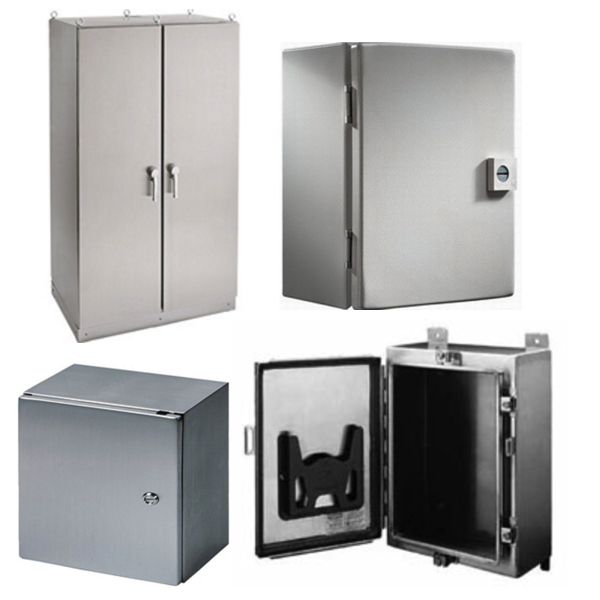Stainless Steel Enclosures

Stainless steel enclosures provide superior corrosion resistance, durability, and safety compliance for both indoor and outdoor electrical protection. Engineered to perform in harsh, demanding environments, these enclosures are widely used in food processing, marine, and chemical industries where hygiene, durability, and environmental protection are critical.
Constructed from high-grade stainless steel, these enclosures feature reinforced doors, secure latches, and IP-rated seals that guard against dust, water, and corrosive elements. Their strength and clean, polished finish make them ideal for industrial automation, control panels, and equipment housing in extreme conditions.
Available in wall-mounted or freestanding configurations, RSP Supply’s stainless steel enclosures come in a variety of sizes and designs, ensuring flexibility and ease of installation. Whether you need an NEMA 4X enclosure for marine environments or a custom configuration for specialized applications, stainless steel enclosures provide the long-term reliability and protection your systems demand.
More Information about Stainless Steel Enclosures
These enclosures are versatile and easy to use, with options for either wall-mounted or freestanding configurations. Many of the models come pre-assembled or ready for custom installation, featuring removable panels and adjustable mounting options for all electrical and electronic components. Not only do stainless steel enclosures ensure robust protection; they also add a polished aesthetic. Their enhanced functionality and appearance have the power to elevate the equipment they house to new levels.
FAQs
Q: What industries use stainless steel enclosures?
They’re commonly used in food processing, marine, wastewater treatment, and chemical manufacturing, where corrosion resistance and durability are essential.
Q: Are stainless steel enclosures corrosion-resistant?
Yes. They’re made from high-quality stainless steel that resists rust, chemicals, and extreme environmental exposure.
Q: What makes stainless steel electrical boxes suitable for harsh environments?
They are constructed from 304 stainless steel with gasketed designs and high NEMA/IP ratings, providing strong resistance to moisture, corrosion, and washdown conditions while supporting reliable electrical performance.
Q: Do stainless steel enclosures meet safety standards?
Yes. They comply with UL, NEMA, and IEC standards, ensuring safe use in industrial and hazardous environments.
Q: Can stainless steel enclosures include custom features like handles or mounting options?
Yes. Enclosures can be customized with pre-installed handles, locks, removable panels, and adjustable mounting plates for added convenience and accessibility.
Why Buy from RSP Supply
At RSP Supply, we provide a full range of stainless steel enclosures from leading manufacturers like nVent Hoffman, Rittal, and Saginaw. Our team helps you select the right configuration for your environment - whether for food-grade, marine, or outdoor industrial use.
We offer fast shipping, competitive pricing, and expert support, ensuring every product you order meets your project’s durability and compliance requirements. Choose RSP Supply for industrial-grade stainless steel enclosures that perform where it matters most.

